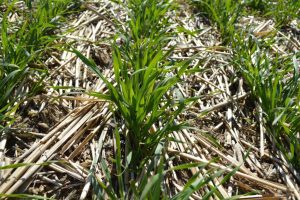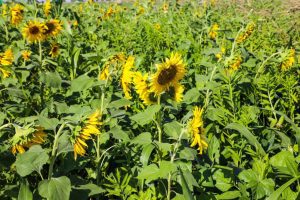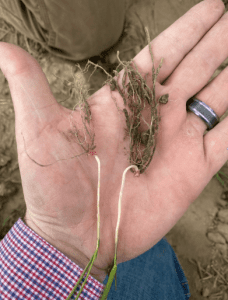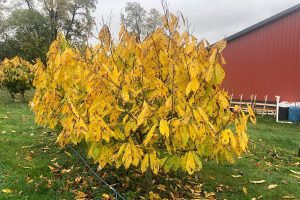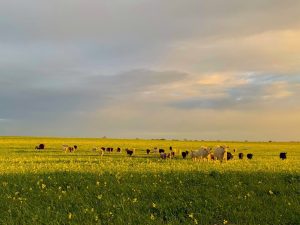The Regenfarming.news summary:
Cover Crops in Cotton: Common practice includes planting winter cereals like wheat after cotton harvest to utilize leftover soil moisture without depleting water for the next cotton crop.
Water Management: Although water is a critical resource for cotton, cover crops can improve water management by enhancing soil moisture retention and reducing evaporation.
Alternative Cover Crop Mix: Scott McCalman uses a mix of Cereal Rye, Field Peas, and Radish, which offers multiple benefits like nitrogen fixation, nutrient scavenging, and creating a mulch layer.
Non-Chemical Termination: Cover crops with similar maturity can be terminated efficiently using a roller crimper, avoiding the need for herbicides.
Disease Management: Cover crops break disease cycles in cotton, with mixed species cover crops showing the greatest reduction in diseases like Black Root Rot and Verticillium Wilt.
Nutrient Management: Legume cover crops can fix significant amounts of nitrogen, reducing the need for synthetic fertilizers and improving nutrient availability over time.
Water Infiltration: Cover crops enhance water infiltration through the creation of soil macro pores and prevent surface sealing on clay soils.
Reduced Evaporation: Cover crop biomass protects the soil from direct sunlight, reducing evaporation and increasing water efficiency during fallow periods.
Risk Management: Cover crops act as a risk management tool by reducing disease pressure, improving water retention, and producing nitrogen naturally.
Additional Benefits: Cover crops also offer weed suppression and increase soil organic carbon, further enhancing soil health and water-ho
Regenerative Cotton Using Cover Crops was first published on Agresol
This year, I had the chance to attend the 2024 Cotton Conference and had the opportunity to meet a number of cotton growers using regenerative practices. These growers farmed across a range of contexts, soils and climates, and included irrigated and dryland cotton. The regenerative cotton practices were mainly utilising cover crops to improve soil health and as part of their nutrition management program. Here are a number of lessons I learnt from these regenerative cotton growers:
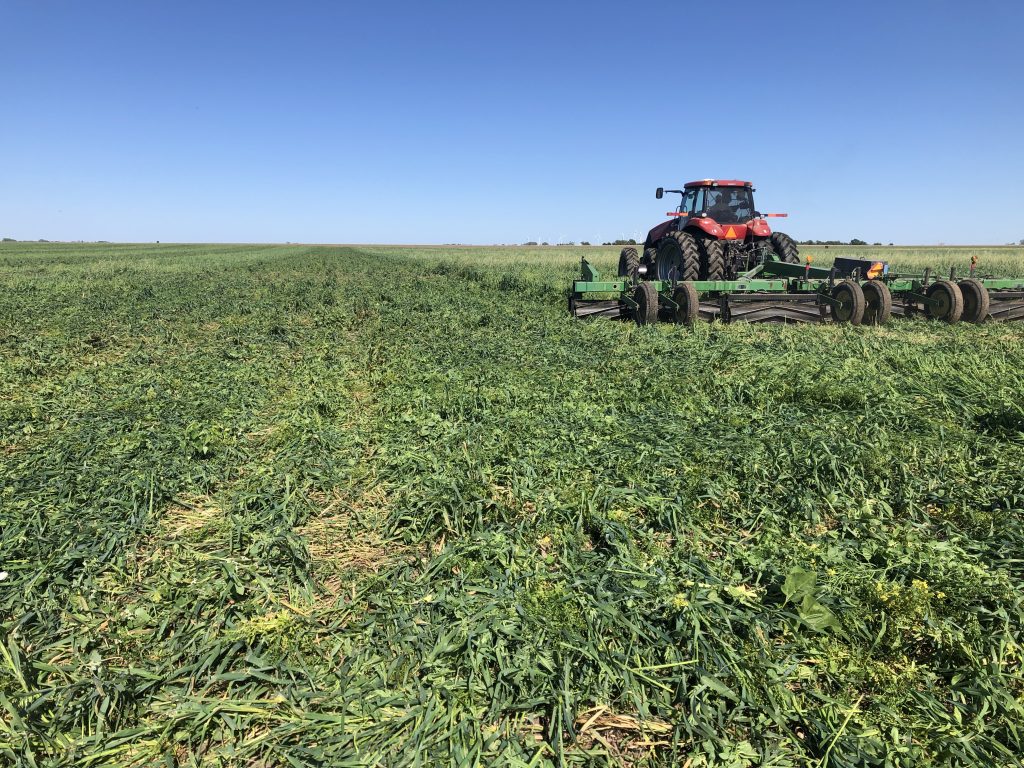
Current Practice For Regenerative Cotton Using Cover Crops
Before we discuss the lessons I learnt from these regenerative cotton growers, its important to discuss some of the current practices for using cover crops in cotton such that it improves soil and landscape health. Much of the Australian cotton region is located in Northern NSW and Southern Queensland (with smaller amounts produced in Southern NSW and Northern QLD), these areas receive their rainfall during the summer months. Cotton is usually grown on heavy clay soils that allow for high water holding capacities. In Australia, water is the most limiting resource for cotton yields and growers need to manage water wisely to ensure yields. Therefore, you could imagine that using water to grow a cover crop is a worrying idea when that water could have been used to supply the following cotton crop with the additional water. However, as we’ll discuss, cover crops can improve water management and contribute a number of different benefits too.
The most common form of cover crop in a cotton system is to use a winter cereal such, as wheat, after cotton is harvested. Using a cereal allows for flexibility where in a good season, the crop can be harvested, or the crop can be terminated in a poor year prior to the plant going into the reproductive phase, as this phase is the most water demanding phase and does not produce any additional biomass. A winter cover crop in these areas would work ideally as leftover soil moisture is utilised for biomass production, and since rainfall tends to fall during summer, this minimises the chance that the cover crop will rob the following cotton crop of water.
A better alternative cover crop mix is used by Scott McCalman that farms near Gunnedah NSW. McCalman a mix of Cereal Rye, Field Peas and Radish as his cover crop. This combination allows for three functional groups (Grasses, Legumes and Brassicas), each of which contributing uniquely to soil health and the functioning of the cover crop. For example, the Cereal Rye produces large amounts of high C:N biomass, this creates a great mulch layer, Field Peas fix nitrogen for both the cover crop to use and the following crop to use after the biomass decomposes and the radish scavenges nutrients, making them more available after decomposition. McCalman grows his cover crop for 12 weeks and terminates using a roller crimper to create a flat mulch. Since these species have a similar maturity time, they can be efficiently terminated without herbicide using a crimper.
For more information on McCalman’s cover crop system, view this Growers Story produced by Cotton Australia and CRDC.
Cover Crops and Disease Management In Cotton
Disease is an important issue in cotton production systems, especially when cotton is grown back to back. Diseases like Black Root Rot (BRR) and Verticillium Wilt (VW) compound under this type of management and significantly reduce yield and increase input cost. A cover crop provides a break in the disease cycle. During the cotton conference, unpublished research showed that all cover crops reduced BRR and VW populations and infection rates. The data showed that brassicas reduced the diseases the most out of any single species, most likely due to a fumigation effect, but the most interesting data was that the mixed cover crop reduced the diseases to the greatest extent. Although the researchers were not sure why, I would suggest that the additional cover crop diversity attracted and nourished a larger diversity and abundance of soil microbes, hence reestablishing an efficient soil food web. This would allow for predation of the disease causing pathogens and protection of the following cotton crop with increased root colonisation from mycorrhizal fungi.
The data would suggest that including a diverse cover crop in a cotton system would reduce disease and improve the following cotton’s yields without needing to apply any more inputs.
Nutrition Management And Cover Crops
Nutrition management is very import for cotton production, where many farmers are routinely apply +200kg N/ha in order to achieve desired yields. Nitrogen tends to be the largest nutritional expense, while also be the largest wasted as excess nitrogen is leached or denitrified back into the atmosphere. It’s estimated that over 50% of nitrogen applied is wasted. An alterative source of nitrogen can be supplied through nitrogen fixation from legumes in a cover crop. Crop crops can fix anywhere from 50 to over 350kg N/ha depending on density and species.
For winter legumes, an average crop of the following could fix:
- Faba Beans – 177kg N/ha
- Field Peas – 161 Kg N/ha
- Lupins – 176 Kg N/ha
After fixing nitrogen, the biomass decomposes and releases to soil microbes and plant roots. A rough rule of thumb is that 50% of a cover crop’s biomass becomes available within one year after termination. This means within a few years of cover cropping, you can fix more than half of your cotton’s nitrogen requirement.
Another way in which nutrition can be better managed with a cover crop is by capturing or scavenges available nutrients such as N and P. Brassicas, such as radish, do a fantastic job at this, and decompose rapidly soon after termination to allow for absorption by the following crop. This allows for less lose of applied N and often incorporates those forms of nutrients into more available and less leachable chelated forms.
Cover Crops and Water Use
Although this seems like a contradiction, cover crops can increase available water through two ways: Reducing evaporation and increasing infiltration. Effectively, we are betting on the idea that the increase in infiltration and reduction in water lose from evaporation is more than the water used from growing the cover crop.
Increased Infiltration
As the cover crop grows, million of roots grow through the soil forming macro pores. Once the cover crop dies, these pores act as little tunnels for water to rapidly flow through into the soil. Once the water moves into the soil, it is stored to use later or loss to evaporation (or deep drainage). If it is raining faster than the rate of infiltration, than water starts to runoff, causing soil erosion and prevents us from capturing that water. Therefore, it is very important to increase infiltration, this can be achieved by increasing these soil macro pores. Another way in which cover crops increase infiltration is by creating a physical barrier between the soil and the raindrop so that a raindrop doesn’t impact the soil causing surface sealing. This is very common on clayey soils and quickly reduces infiltration as the soil pores get clogged and prevent water flow.
Reduced Evaporation
After a cover crop is terminated, the biomass protects the soil surface direct sunlight and creates a small microclimate. This reduces evaporation as the soil surface is cooler and humid. When soil is 10% covered, it is only 15% efficient at storing water during fallow, whereas when soil is 70% covered with litter, it is 25% efficient at fallow. This additional 10% may be the difference between a producing a crop or not.
Risk Management Using Cover Crops
Overall, cover crops should be seen as a risk management strategy used to reduce the risk of crop failure by reducing disease pressure, capturing and storing more water and by producing your own nitrogen. There are a number of different benefits from cover crops that we didn’t mention such as weed suppression, and improvements to the soil’s organic carbon stock that would increase soil water holding capacity (For more on soil organic carbon benefits, check out our free soil carbon course).
Regenerative Cotton Using Cover Crops was first published on Agresol






